Text
The innate rage of toddlers

love reading about ancient authors talking about young children because they almost inevitably say something unhinged. did you know all children contain a bloodthirsty vengeance in their heart
972 notes
·
View notes
Text
Victorian Dress For Every Occasion - 1890s Edition
The Victorian period was much about appearances and very specific etiquette, especially when it came to clothing. They had dressing etiquette for literally every activity during the day and people changed their outfit many times a day, especially in upper class circles. It honestly gets very convoluted so I decided to look into it more deeply. Not understanding the dress etiquette of the times creates a lot of weird costumes in period drama for example, where a dress might have elements of real extent garments, but they are combined in ways that would make no sense to Victorians.
To limit this post and my research I’m looking into 1890s. I also think it gives better idea about the differences between the outfits if they are all from the same decade. I’ll also limit myself to upper class and women’s clothing. I think it would be interesting to look at men’s dress etiquette and etiquette of the lower classes, but alas it has to be another post.
The broad strokes are that from the turn of the 19th century to WW1 during the day you would wear long sleeves and little to no cleavage and in the evening you could show more skin, except when dining. The specifics shifted from time and place.
Nightgown

Nightgown, as you might guess, was worn for sleeping. They started as basically shifts, the very basic under dress worn next to skin, but during the Victorian Era they became increasingly elaborate and when 1890s was reached they were profoundly extra. You would never show yourself in your nightgown alone. For them it was probably pretty much the same as wearing only your underwear. Even in your bedroom or dressing room you would cover it up, which leads us to…
Dressing Gown
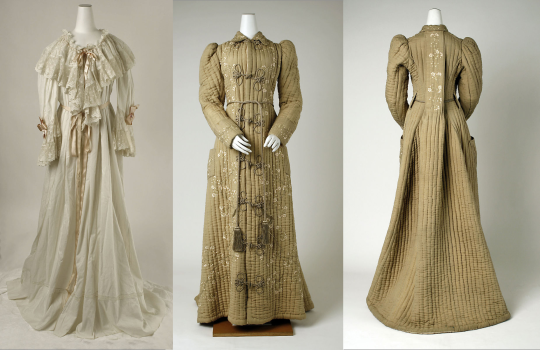
Dressing gown was exactly what was used to cover nightgown. In some sources I’ve seen this called wrapper. But basically it was a glorified bathrobe. It was not used outside your own private chambers, but inside them while you got ready for the day. It was usually long and loose comfortable robe, often tied by waist with a cord. During summer they were light and in winter they might have been woolen or from quilted fabric for warmth. They were heavily inspired from especially Japanese kimono as Orientalism was very in in Europe during 19th century. Under it a ribbon corset or morning corset could be used, but that was not necessary. Ribbon corset was made entirely of thick ribbons and ended under the bust, with only couple of bones to keep it in shape, and morning corset doesn’t have cording and instead is just wrapped around the torso. They were made for comfort and bust support and didn’t shape heavily or reduce waist.
Wrapper

Wrapper or morning dress was used during the morning in the comfort of home. The terminology around this type of clothing is murky and they had a lot of overlap with tea gown and dressing gown. Some primary sources described wrapper as something you can wear on top of a dress to keep the dress clean and others as plainer and looser version of the day dress. Most extent garments, I found from 1890s, were the latter type. The former sounds something that could be used as a dressing gown too, which would explain, why the dressing gown was called wrapper in some sources. What I have gathered, is that earlier in Victorian era wrapper meant something similar to dressing gown, but maybe more presentable or dress-like, worn over a morning dress of just the undergarments. I think by the 1890s the whole outfit worn in morning had begun to be referred as wrapper, since I had a hard time finding morning dresses dated to 1890s. Regardless of the terminology, in 1890s wrapper was used in home outside personal chambers. It was acceptable to receive early visitors in it, but it was very informal and mostly reserved for very close people. It was plain and practical, but when it comes to rich people it became increasingly elaborate during Victorian era. It’s a theme here. It was often loose, but it could be more or less structured (often less). Under it you would usually wear all the typical undergarment layers (combinations or shift with drawers, corset, corset cover and petticoat), though morning or ribbon corset could be worn instead of the normal one.
Tea gown
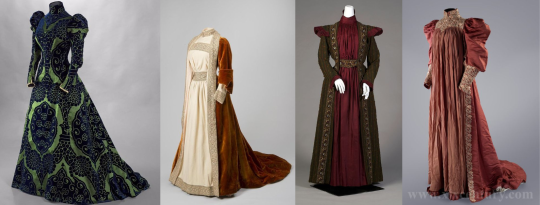
Tea gowns started as house dress, basically an open presentable wrapper worn over a fancier petticoat or morning dress, but by the 1890s it became somewhat of a statement piece. At first it was seen as tacky to be too dressed up in your own home, even when receiving guests, but I think we have established that 1890s Victorians were very, very extra. Tea gowns were worn for receiving house guests during the day and in the late Victorian era, as tea gowns had become so extravagant, they were also used in the evening for receiving casual gatherings of close friends or family. Similar to wrappers, they were looser than clothing worn outside, but could be structured or lack any structuring at all. Except they were made from more expensive materials and had much more detailing. They also often had drains and a real or fake open robe-like thing, which I assume was a nod to house dresses. All the undergarments were worn under it, but morning or ribbon corset could be used under it, if very close friends were visiting. Very loose tea gowns (like the pink one on the right) were inspired from the Victorian counter culture fashion movement, Aesthetic movement, which rejected the rigid Victorian silhouette.
Day dress

Day dress or afternoon dress was formal and elaborate, as it was used outside of home and meant to be seen. Unlike the gowns reserved for home usage, it was generally made from two pieces, bodice and skirt. But of course, you would always wear matching pieces. It had long sleeves and high neckline. As the name reveals, it was worn during daytime. It could be worn for visiting and then, especially when visiting close friends or relatives, it could have slightly shorter sleeves or lower neckline, but not as low as with evening wear. It was also worn for promenading outside. When used for carriage rides train was acceptable, when for walks, shorter one was seen as preferable, but as we know Victorians were extra and sometimes still wore a train. Since weddings were (and are) held during the day, a day dress was used for that too. The finest day dress was used of course and after queen Victoria’s wedding white became the most popular color. People who weren’t rich, might have still opted out from it, as pure white dress was very expensive.
Walking dress
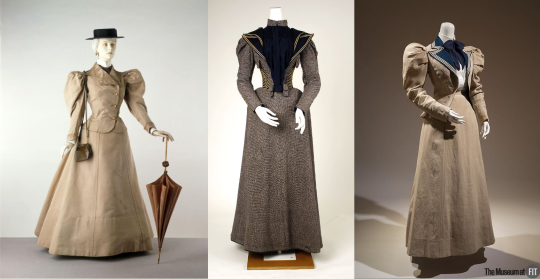
Walking dress was, you guessed, used for walking. Victorians were really into city walks and would use a walking dress for looking around in cities. It was a type of day dress but much more practical and less elaborate. It was usually made from sturdier materials and the skirt was short enough to reveal shoes. It often had a skirt, blouse and a coat, sometimes a waistcoat too. Because of it’s practicality, it was often used for travelling too.
Dinner dress
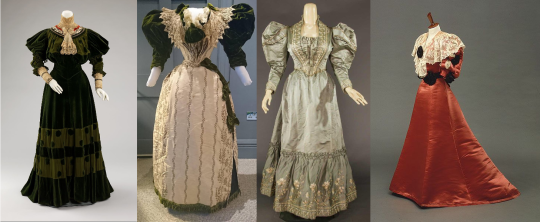
Dinner dress was used in evening, but unlike other evening dresses, more skin coverage was appropriate. Sleeves could be as short as elbow length and neckline could be more open than with day dress. As the name suggests, it was used for dining and dinner parties.
Evening dress
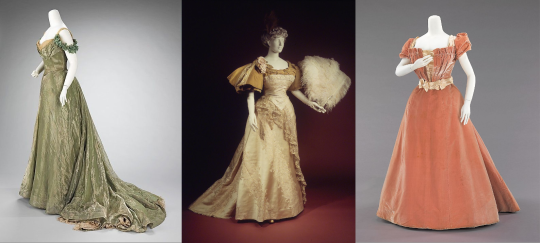
Evening dress was the fanciest of them all and the most official. It had short sleeves or only straps (in the middle of the decade huge sleeves very very fashionable) and low and wide neckline. It was used in fancy evening occasions when presenting yourself for the high society. Balls were of course the main events of high society, there every one would put on the best they had, there was no holding back. For opera people also dressed to be seen and would dress up, but for theater a little toned down look was more appropriate.
It was very common to have bodices for different occasions (day/evening/dinner) made for the same skirt, so same material and style, but different sleeve lengths and necklines. Clothing were very expensive and the skirt had the biggest amount of fabric making it the most expensive part, so it was very economical to use the same skirt for different occasions.
2K notes
·
View notes
Photo

Juliana of Hesse-Eschwege was described as a great beauty but there are no portraits of her. The portrait shown is of her mother.
Juliana was taken to the royal Swedish court to be brought up there as the future queen of Sweden by queen dowager Hedwig Eleonora of Holstein-Gottorp, with the prospect of being married to her cousin, Charles XI, when he reached adulthood.
These plans never came about. In 1672, during a carriage ride in Stockholm with the queen dowager, Juliana fell to the floor of the carriage in labour. The father of the child proved to be a married officer of the court, Count Gustaf Lillie. The count was exiled, and Juliana was sent to the country, where she was given her own estate and court. The child, a son, was named after his father, Gustaf Gustafsson Lillie, was later raised by Baron Gustaf Adolf von der Osten. His fate is unknown.
The estate Juliana was sent to was run by a Dutch housekeeper named Marchand, who was the widow of a grocer, and she had a son, Johan Jakob, with him. This would be the second time Juliana became pregnant out-of-wedlock. In 1679, Juliana's cousin, King Charles, gave her his permission to marry her lover, who was given the title Baron von Lilienburg. They married on 22 February 1680 in Sweden.
The couple moved far away from the Swedish court to the Netherlands, where Johan was offered a government position in IJsselstein by Stadtholder William III, who was distantly related to Juliana. The couple had eight children. Juliana died in IJsselstein in 1693, followed by Johan 1703.
I found Juliana interesting because her mother had a similar scandal to hers: After her wedding to Frederick, Landgrave of Hesse-Eschwege, Eleonora confessed before her husband, "on her knees", that she had had a six week affair with French lute-player Beschon, and was pregnant with his child. Frederick decided to act like nothing happened and hide the matter, but it became a known scandal.
Beschon wrote a composition to Eleonora which he sent her along with a letter dated 28 February 1647, but she gave it to her brother; these documents are now preserved in the Stegeborg collection.
#Eleonora Catherine of the Palatinate-Zweibrücken#Juliana of Hesse-Eschwege#swedish history#history#Frederick Landgrave of Hesse-Eschwege#Charles XI#Count Gustaf Lillie#scandals#scandal#history scandals
2 notes
·
View notes
Text
Hello fellow nerds!
Since it's a season of...something...mostly lights...do me a favour would you? You know this image of Tutankhamun?
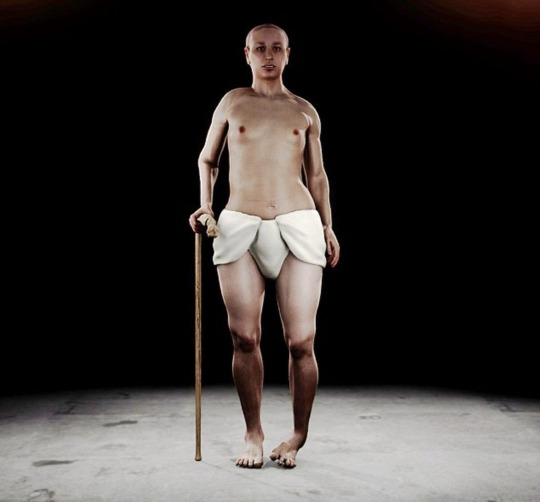
The documentary it comes from was terrible. It grossly exaggerated some deformities present on Tutankhamun's mummy, and is not even remotely how he looked in real life. The people who did this study never had access to his mummy, and really fudged their conclusions for a 'showstopper documentary' so much so that the Egyptian government was angry about it.
Lets list the things that are wrong!
The 'wide hips' only exist on this model because they wanted him to look more 'Amarna like'. The loin cloths found in his tomb are all standard size.
He doesn't have an overbite. This is a result of poor mummification and Carter's poor treatment of the mummy when removing it from the death mask.
He does have a cleft palate, but it's in the soft palate and he wouldn't have noticed it.
He doesn't have a severe club foot. Medical professionals have examined him repeatedly over the years. None have ever pointed it out bar the noting of a 'slight rotation' which wouldn't have been noticeable when he walked if this is indeed a club foot and not another mummification mess up. He would not have needed a staff to walk with this slight rotation. Some staffs in his tomb show wear, but it is normal in Egyptian society to walk with a staff as a sign of power. He has 120 and only 3 show slight wear.
The articles about him 'always being seated and thus very disabled' fail to note that it is common for Pharaoh's of this period to be depicted seated, and there are numerous depictions of him standing doing actions too.
This documentary made him look as bad as possible, based on terrible science, and now every time someone doesn't depict him 'gross and disabled' people complain that he's not 'ugly enough', which is ableist as hell alongside the already ableist exaggerated CGI depiction.
I would sincerely like this terrible recreation to die. Many thanks.
7K notes
·
View notes
Photo
This is BEAUTIFUL.


Red silk velvet dress from the House of Worth with changeable bodices, c. 1893-95
2K notes
·
View notes
Text

2,300-Year-Old Plush Bird from the Altai Mountains of Siberia (c.400-300 BCE): crafted with a felt body and reindeer-fur stuffing, all of which remains intact
This artifact was sealed within the frozen barrows of Pazyryk, Siberia, for more than two millennia, where a unique microclimate enabled it to be preserved. The permafrost ice lense formation that runs below the barrows provided an insulating layer, preventing the soil from heating during the summer and allowing it to quickly freeze during the winter; these conditions produced a separate microclimate within the stone walls of the barrows themselves, thereby aiding in the preservation of the artifacts inside.
This is just one of the many well-preserved artifacts that have been found at Pazyryk. These artifacts are attributed to the Scythian/Altaic cultures.
Currently housed at the Hermitage Museum.
45K notes
·
View notes
Photo
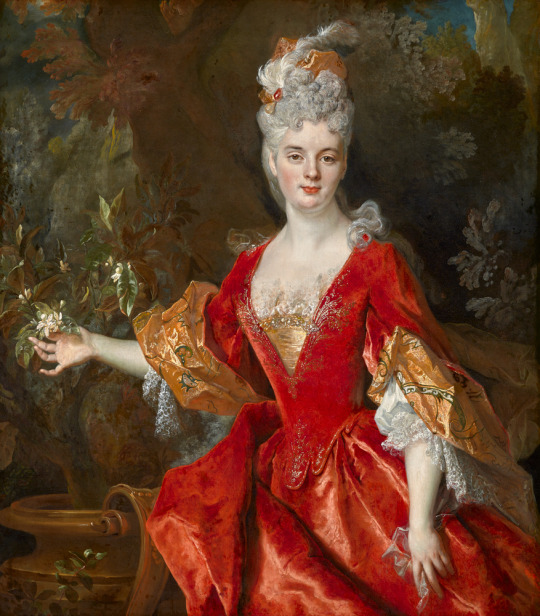
I absolutely love this painting and the dress and more people should be seeing it.
Portrait of a young woman, known as Jeanne-Elisabeth de Beauharnais
Former title: Portrait of a Lady of the Barral Family 1711
by Nicolas de Largillière
She married on January 9, 1711 (date of the painting) in Orléans with Michel Bégon de la Picardière.
#1700s#18th century#art#dress history#history#art history#jeanne-elisabeth de beauharnais#nicolas de largillière
308 notes
·
View notes
Text




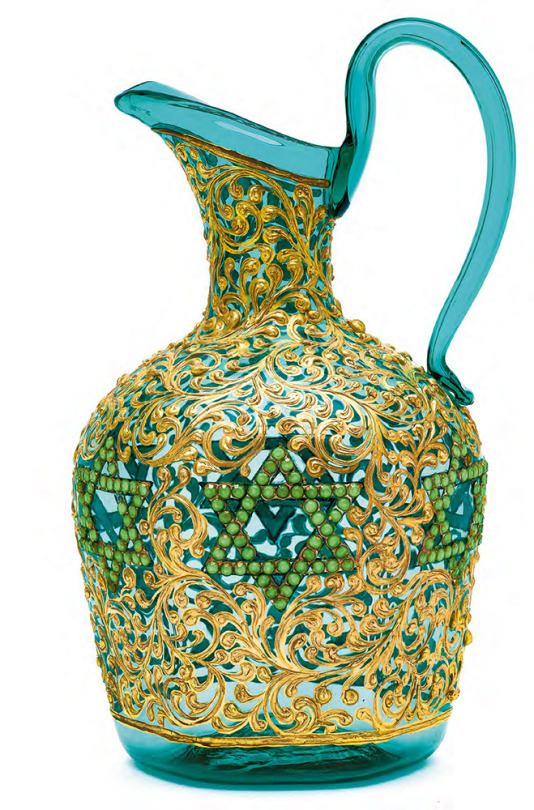
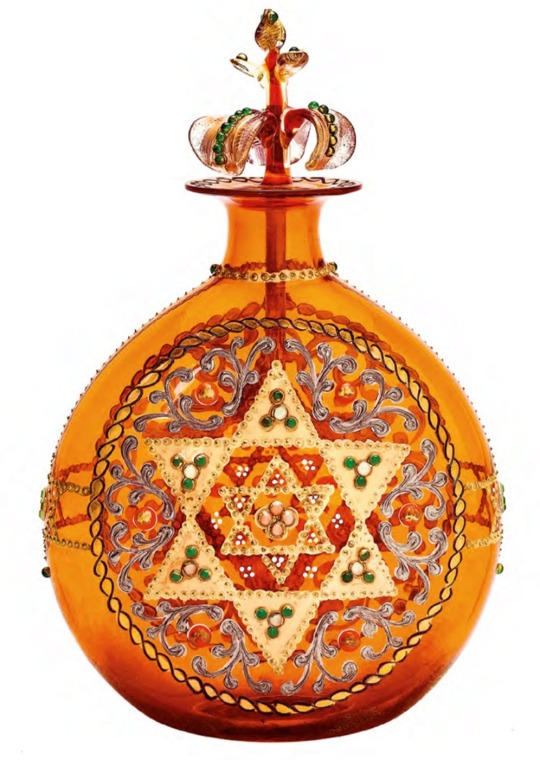


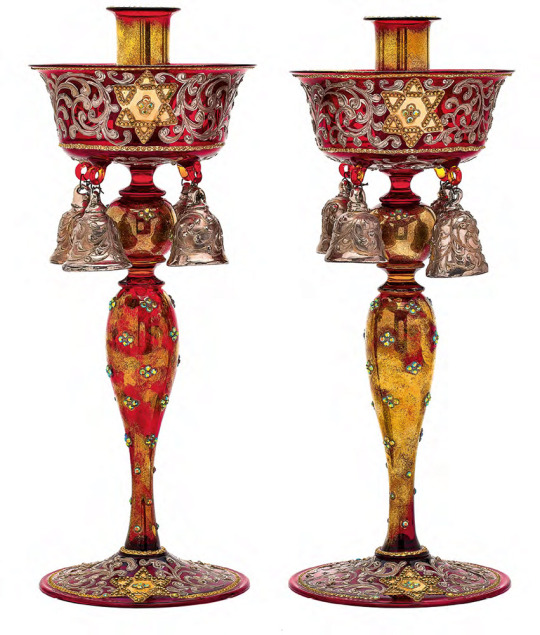
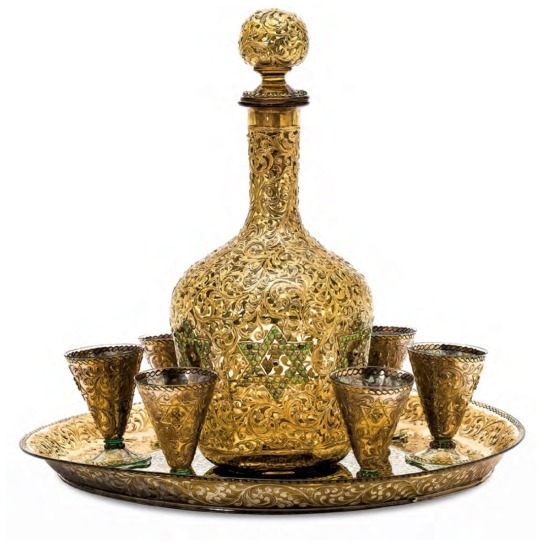
Murano glass Judaica. Italy, XIX-XX century.
The uniqueness of this collection, which has been formed for a long time, lies in the fact that all items intended for synagogue events and domestic rituals are made of glass - a material that has not been used in Judaica, unlike metal, in wide demand. Due to the fragility of the material and the destruction of Jewish ritual objects during the WWII, such things are few and far between and are extremely rare in collections.
12K notes
·
View notes
Photo
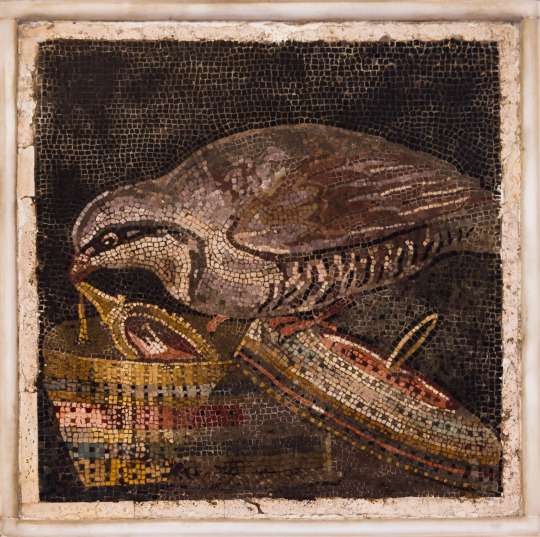
Mosaic “The thief partridge”, from House of the Labyrinth, Pompeii.
Naples Archaeological Museum, Italy.
By Jebulon (CC0)
1K notes
·
View notes
Photo



Found in Pompeii
Oil lamp. Handle in the shape of a donkey. Knocker.
Naples Archaeological Museum, Italy
Photos by Gary Todd (CC0)
326 notes
·
View notes
Photo
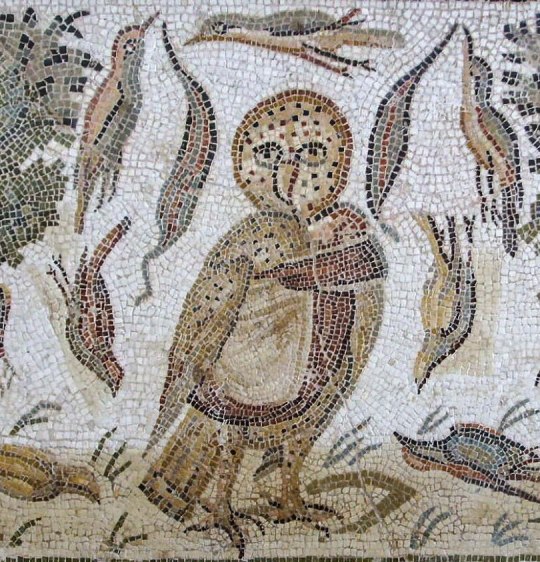
Pliny the Elder said Rome had to undergo a purification of the entire city because an owl found its way into the Capitolia during the consulship of Sextus Palpelius Hister and L. Pedanius because owls are considered a direful omen and then they made mosaics of owls that looked like this
440 notes
·
View notes
Photo
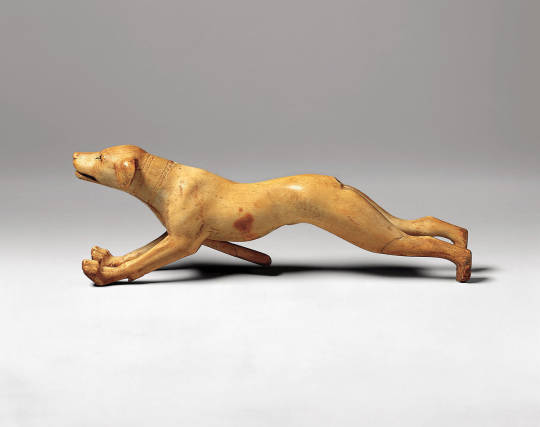

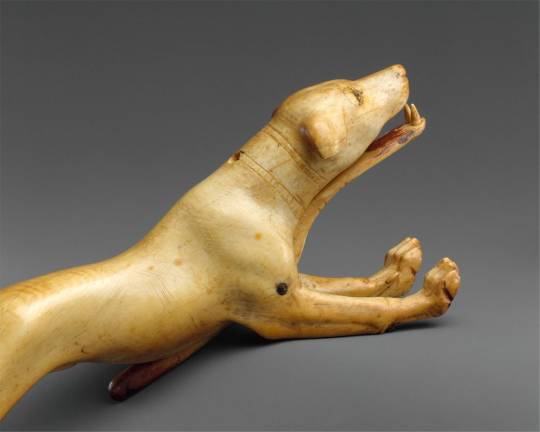
Currently thinking about this little mechanical dog.
This leaping hunting dog can be made to open and close its mouth using the lever beneath the chest. Originally secured by means of a thong tied through the hole in the back of its neck and two in the throat, the lever was later attached with a metal dowel in the right shoulder. When the mouth is opened, two teeth and a red tongue are visible. It is made of elephant ivory and was made c. 1390–1353 B.C. during the reign of Amenhotep III.
5 notes
·
View notes
Photo

Amulets of women - maybe valkyries (6th century, Sweden)
1K notes
·
View notes
Text
Only thing getting me through today is the thought of Starred Egyptian Tomb Ceilings
49K notes
·
View notes
Photo

The plundering of the Valley of the Kings wasn’t just done by bands of tomb robbers. Most of the emptying of the royal tombs was carried out officially by workers of the Necropolis, under orders from the high priests of Amun. The project was led from the beginning by Butehamun, one of the most famous scribes involved in the building of the royal tombs of the Valley of the Kings.
Ramses II was Egypt's most prolific builder and spent so much that he emptied the royal coffers and by the time of Ramses III, supplies in the state granaries were low and the grain which formed the monthly wage rations of state employees like tomb builders and artisans was no longer paid when due. This sparked the first recorded labour strike in 1155 BC.
The workers laid down their tools and staged a sit in at the temple but the state's response was to hand out a delivery of pastries, an ancient 'let them eat cake.' In response to the government's indifference, the workers only became angrier and began shouting and harassing the local officials for weeks. They were finally given enough supplies to calm them down just in time for the Pharaoh's jubilee celebration but the striking workers had highlighted the waning power of the monarchy.
Now, the Pharaoh's rivals were the high priests of Amun. (In the picture, the high priest of Amun Amunhotep and the pharaoh Ramesses IX are shown in equal size. For the first time, they are the same height meaning that they are of equal importance.) The priests had become powerful politicians and had ambitions to rule and they did so, finally taking control over the entire south (Upper Egypt) and thus dividing Egypt into its ancient halves.
These politician priests were only concerned with their power and wealth, no longer caring about the sacred afterlife. Butehamun was key to the priest's corrupt ambitions and the high priest himself ordered Butehamun and his men to go to the Valley of the Kings, open the ancient tombs, and remove all the gold they could find. This was tomb robbing sanctioned by the state.
Butehamun did his job, beginning c. 1081-1069 BC, breaking open the seals of royal tombs and removing the mummies, unwrapping them and removing any gold and jewels they found. The mummies were rewrapped and repackaged in incorrect coffins with incorrect lids, basically tossed together haphazardly. Only one tomb, hidden by rubble, escaped the plunder: Tutankhamun's.
24 notes
·
View notes
Photo


Scythian Tattoos Appreciation. I
Kurgan II of Pazyryk, Altai. Right upper arm of a Scythian men with tattoos showing animals and hybrid creatures. 5th century BCE.
Original skin (left) and outline (right).
Source: Under the Sign of the Golden Griffin. Royal Tombs of the Scythians (2007).
4K notes
·
View notes
Photo




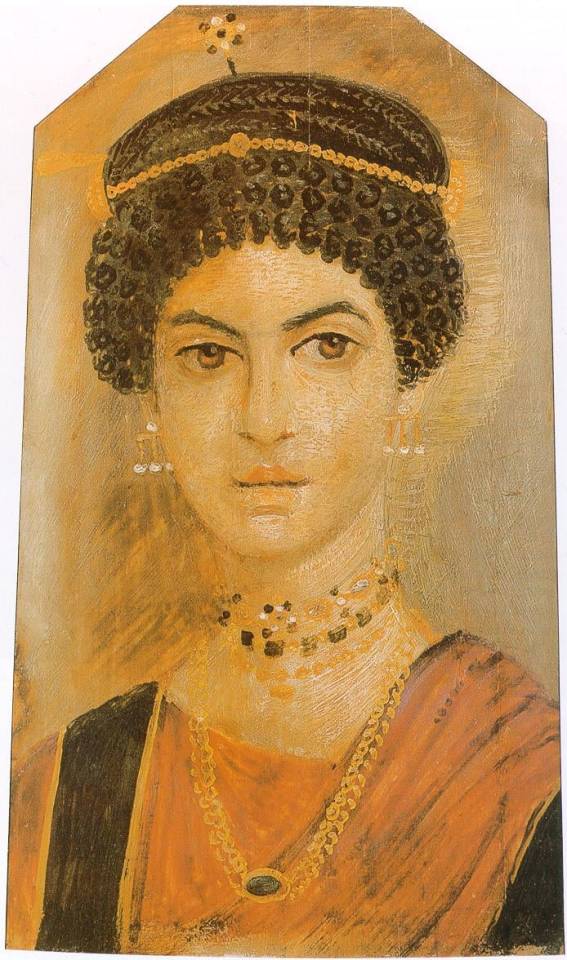

Roman-Egyptian funerary portraits... with great jewellery!
20 notes
·
View notes